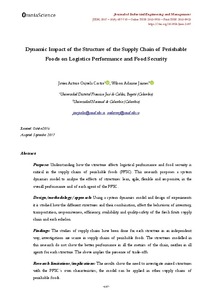Mostra el registre d'ítem simple
Dynamic Impact of the Structure of the Supply Chain of Perishable Foods on Logistics Performance and Food Security
| dc.contributor.author | Orjuela Castro, Javier Arturo |
| dc.contributor.author | Adarme Jaimes, Wilson |
| dc.date.accessioned | 2017-11-07T16:22:06Z |
| dc.date.available | 2017-11-07T16:22:06Z |
| dc.date.issued | 2017-10 |
| dc.identifier.citation | Orjuela Castro, J. A.; Adarme Jaimes, W. Dynamic Impact of the Structure of the Supply Chain of Perishable Foods on Logistics Performance and Food Security. "Journal of Industrial Engineering and Management", Octubre 2017, vol. 10, núm. 4, p. 687-710. |
| dc.identifier.issn | 2013-0953 |
| dc.identifier.uri | http://hdl.handle.net/2117/110095 |
| dc.description.abstract | Purpose: Understanding how the structure affects logistical performance and food security is critical in the supply chains of perishable foods (PFSC). This research proposes a system dynamics model to analyse the effects of structures: lean, agile, flexible and responsive, in the overall performance and of each agent of the PFSC. Design/methodology/approach: Using a system dynamics model and design of experiments it is studied how the different structures and their combination, affect the behaviour of inventory, transportation, responsiveness, efficiency, availability and quality-safety of the fresh fruits supply chain and each echelon. Findings: The studies of supply chains have been done for each structure in an independent way; investigations are scarce in supply chains of perishable foods. The structures modelled in this research do not show the better performance in all the metrics of the chain, neither in all agents for each structure. The above implies the presence of trade-offs. Research limitations/implications: The results show the need to investigate mixed structures with the PFSC´s own characteristics; the model can be applied in other supply chains of perishable foods. Practical implications: Management by combining structures in the PFSC, improves logistics performance and contributes to food security. Social implications: The agents of the FFSC can apply the structures found in this study, to improve their logistics performance and the food security. Originality/value: The dynamics of individual and combined structures were identified, which constitutes a contribution to the discussion in the literature of such problems for FFSC. The model includes six echelons: farmers, wholesalers, agro-industry, third-party logistics operators and retailers. The dynamic contemplates deterioration rate to model perishability and others losses. |
| dc.format.extent | 24 p. |
| dc.language.iso | eng |
| dc.publisher | OmniaScience |
| dc.rights | Attribution-NonCommercial 3.0 Spain |
| dc.rights.uri | http://creativecommons.org/licenses/by-nc/3.0/es/ |
| dc.subject | Àrees temàtiques de la UPC::Economia i organització d'empreses::Direcció d'operacions |
| dc.subject.lcsh | Business logistics |
| dc.subject.lcsh | Physical distribution of goods |
| dc.subject.lcsh | Food--Storage |
| dc.subject.lcsh | Food industry and trade |
| dc.subject.other | Perishable food supply chain structure |
| dc.subject.other | Dynamic system |
| dc.subject.other | Fruits |
| dc.title | Dynamic Impact of the Structure of the Supply Chain of Perishable Foods on Logistics Performance and Food Security |
| dc.type | Article |
| dc.subject.lemac | Logística (Indústria) |
| dc.subject.lemac | Distribució de mercaderies |
| dc.subject.lemac | Aliments -- Indústria, comerç |
| dc.subject.lemac | Aliments -- Emmagatzematge |
| dc.identifier.doi | 10.3926/jiem.2147 |
| dc.identifier.dl | B-28744-2008 |
| dc.description.peerreviewed | Peer Reviewed |
| dc.rights.access | Open Access |
| local.citation.publicationName | Journal of Industrial Engineering and Management |
| local.citation.volume | 10 |
| local.citation.number | 4 |
| local.citation.startingPage | 687 |
| local.citation.endingPage | 710 |
Fitxers d'aquest items
Aquest ítem apareix a les col·leccions següents
-
2017, vol. 10, núm. 4 [10]
Special Issue - Logistics Systems Design in Latin America


